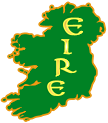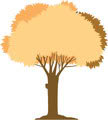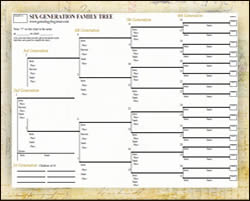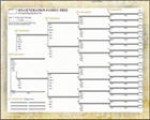Introduction to Genealogy
Broaden Your Ancestor’s Name Search
September 11, 2008 by Chris
Filed under Articles, Genealogy and Surnames, Introduction to Genealogy, Lesson 5 Articles, Public Records
 To trace the Irish origins of a client’s Irish grandfather, I recently searched a number of government record databases. The Irish grandfather’s name was Thomas Hogan. Feeling confident in pinpointing the specific person, I entered the first name, Thomas, and the family name (surname), Hogan, in the search fields of the searchable database. My confidence quickly diminished, when, unfortunately, the search results did not produce the one and only Thomas Hogan I was looking for. Being patient and persistent, I took a chance and broadened the search by simply entering the family name (surname), Hogan, in the search field.
To trace the Irish origins of a client’s Irish grandfather, I recently searched a number of government record databases. The Irish grandfather’s name was Thomas Hogan. Feeling confident in pinpointing the specific person, I entered the first name, Thomas, and the family name (surname), Hogan, in the search fields of the searchable database. My confidence quickly diminished, when, unfortunately, the search results did not produce the one and only Thomas Hogan I was looking for. Being patient and persistent, I took a chance and broadened the search by simply entering the family name (surname), Hogan, in the search field.
Although, as you can guess, this wider search produced hundreds of records, I hoped that it might uncover the correct Thomas Hogan.
Eureka! Lo and behold, the “Hogan only” search produced a record for a “Thos. Hogan”, the correct one, the grandfather I was looking for. The lesson learned: before giving up and suspending your search for a specific first name-last name combination, broaden your search to include an abbreviated first name. You may ultimately find the person you are looking for!
Footnote: To quicken the creation of a written form or record, a government official sometimes abbreviated the first name of a person in that form or record. Today, searchable electronic databases contain those same abbreviations.
See more Irish family history articles and lessons learned in earlier posts below and in the archives.
…
Where to Next?
Blank Family Tree with Step-by-Step Instructions
…
How to Research Your Family Name
May 18, 2008 by Chris
Filed under Genealogy and Surnames, Getting Started, Introduction to Genealogy, Lesson 5 Articles
 By Dakota Caudilla
By Dakota Caudilla
You’ll be surprised with the kind of information you’ll unearth when you do a research on your own family name. People you’ve never known existed, long-lost relatives, and friends who share the same lineage as you! This is what researching your own surname can do for you. If you’re not ready for some surprise findings, you’re better off leaving all this researching to others in your family.
Researching your own surname can be done through different methods. For one thing, the most popular among all the other methods of researching your own family surname is through the Internet. The wide availability, freedom of use and flexibility of the internet makes it the most popular genealogical research tool known to humankind today!
Try websites like http://www.genealogy.com and you’ll see what we mean. By typing in your surname or your ancestor’s first and last name, you’ll come up with a whole list of possible family members that you can easily fill up your family tree. These tools are generally easy to use and some websites even have communication tools whereby you can contact the possible relative directly too. These websites contain hundreds of millions of family names in their database to help people find long-lost family members.
Continue reading “How to Research Your Family Name” »
Maps of Historic London
March 8, 2008 by Chris
Filed under Genealogy Searches by Place, Introduction to Genealogy, Public Records
 The folks over at Genealogy Insider have brought us a great post on London Maps. In an article by Grace we learn about the virtual exhibition of historical maps of the city from the British Library. This is a must visit, titles like this one from a map dating from 1653 should spark your interest for more.
The folks over at Genealogy Insider have brought us a great post on London Maps. In an article by Grace we learn about the virtual exhibition of historical maps of the city from the British Library. This is a must visit, titles like this one from a map dating from 1653 should spark your interest for more.
‘A guide for Cuntrey men In the famous Cittey of LONDON by the helpe of wich plot they shall be able to know how farr it is to any Street.’
In this exhibit you will find 40 historic plats organized via Google maps that can easily help you clarify the areas they correspond to. If you prefer, you also have the option of looking at maps by time period.
You can access the full post by clicking here. It is really amazing how things are changing with the internet. There is no end to the resources available to us all in our search for our ancestors.
…
Not interested in the map?
Blank Family Tree with Step-by-Step Instructions
…
Are You up to Date? By Paula Stuart-Warren, CG
February 20, 2008 by Chris
Filed under Introduction to Genealogy, Organizing Your Genealogy Research, Public Records
 I came across a heartfelt genealogy post at another blog and felt it was very much worth sharing. In her article, “Are You Up to Date,” Paula Stuart-Warren writes about keeping your family tree current with events in your family. While we may spend the majority of our time looking for distant ancestors, we need to remember to enter recent family data as well. She also discusses such topics as:
I came across a heartfelt genealogy post at another blog and felt it was very much worth sharing. In her article, “Are You Up to Date,” Paula Stuart-Warren writes about keeping your family tree current with events in your family. While we may spend the majority of our time looking for distant ancestors, we need to remember to enter recent family data as well. She also discusses such topics as:
- Obituaries and Tombstones
- Family Group Sheets
- Funeral Guest Books
- Social Security Death Index
- Other key considerations
Paula, if you read this, my condolences and thank you for sharing such a great article. It is truly the testament you intended and a solid introduction to Genealogy and thus I felt it fitting to share it with the visitors here.
You can read Paula’s full article here.
Thank you – Chris
You’ve Got your Blank Family Tree Form to Print, What Next?
February 9, 2008 by Chris
Filed under Blank Family Tree, Getting Started in Genealogy, Introduction to Genealogy
 In this article, Mr. David Chandler tells us what we need to do after we’ve downloaded our blank family tree form to print. He walks us through the idea of “audit trails” which will help you move from step to step.
In this article, Mr. David Chandler tells us what we need to do after we’ve downloaded our blank family tree form to print. He walks us through the idea of “audit trails” which will help you move from step to step.
The Family Tree
By: David Chandler
There are numerous genealogy sites out there that feature an assortment of articles on documentation of records for doing your genealogy search. We will look at how genealogy sites and the tools they offer will assist you to carry on a search.
Genealogy sites have plenty of tools that you use to keep records of your searches, but keeping records is not enough. You must know where to search next once you have found that piece of information that you are looking for. Genealogists usually draw conclusions from their records, to continue to dig deeper into the roots of their ancestry, which is often referred to as and audit trail.
An ‘audit trail’ requires that the thought process and analysis be included by documenting sources. Genealogy sites generally offer some software that is capable of analyzing the data and there are services from expert genealogists.
The fees from experts vary from site to site, but they are not always needed unless you get stuck and cannot find the additional information that you are looking for in your search or if you cannot go any further on your own. There are many purposes for an audit trail but one of the main reasons is for subsequent searches to obtain the records that were used and see how the initial researcher came to their conclusions. Keeping records is very important, along with maintaining them in a secure and good condition.
Suggestions for making an audit trail:
- When you make an assumption, clearly state why you came to the conclusion and any other information that could be useful. This can be the on the front page of your record and can be edited at anytime, remember that new information changes the search direction.
- By learning any historical background of the time period and region, will allow you to have a better of idea of what direction may be the next direction to head in. Most genealogy sites offer this information to you for this purpose.
- Learn as much information as you can about your ancestors, such as how they lived, their culture and any other relevant information that will help guide you in your search.
- Cite your sources, as this can lead you back to the information you need, or may add additional information for future searches that are completed.
- Writing notes in detail will make it easier for people who carry on your work in the future. This will allow them to see your thought process.
Make sure that you information is as accurate as possible, do not jump to conclusions. You can make the search nearly effortless, by leaving and audit trail which allows you or others to carry on the search easily.
(This article was written by David Chandler. Please visit some other articles written by Mr. Chandler by clicking on the link which is the author’s name.)
…
Where to Next?
…
Free Obituary Templates
February 8, 2008 by Chris
Filed under Genealogy Reports and Charts, Introduction to Genealogy, Public Records
 When reviewing obituaries, it is helpful to know that most follow a fairly standard template format. However, it seems there may be some confusion as to what this format is and, when reviewing or writing an obituary, what type of format to use or expect. To assist with this, we’ve reviewed a number of free obituary templates sites and present two of them here for your research. Please let us know if we missed anything.
When reviewing obituaries, it is helpful to know that most follow a fairly standard template format. However, it seems there may be some confusion as to what this format is and, when reviewing or writing an obituary, what type of format to use or expect. To assist with this, we’ve reviewed a number of free obituary templates sites and present two of them here for your research. Please let us know if we missed anything.
This website has suggestions for those who wish to write an obituary for themselves or for a loved one. The purpose is to help one write an obituary that is lively, accurate and memorable.
You can visit their section on templates by clicking here.
Write Express
Write Express is a site that sells letter writing software. However, it also has an interesting tip about writing obituaries that may help for those looking for free obituary templates.
Writing an obituary will never be easy, but if the task has fallen on your shoulders, a good set of free obituary templates may assist you in doing it well.
…
Where to Next?
Blank Family Tree with Step-by-Step Instructions
…
Free Family Tree Templates (Blank Family Trees)
February 3, 2008 by Chris
Filed under Blank Family Tree, Genealogy Reports and Charts, Introduction to Genealogy
 Visitors to Genealogy Beginner are often looking for family tree templates they can use to get a better understanding of what their family tree should look like.
Visitors to Genealogy Beginner are often looking for family tree templates they can use to get a better understanding of what their family tree should look like.
Click here to download the template
A couple days after you download your tree we’ll show you another great place to find an archive of hundreds of thousands of images of family trees. Great to develop ideas and explore new formats.
We’ll also direct you to a list of link that will direct you to a web page where you can download free blank family trees. We’ve avoided any sites that require registration and reviewed everything to make sure there were no strings attached.
When you download your free blank family tree we’ll ask for your email address so we can send you this follow-up information along with great tips and techniques to help you start your genealogy project.
As we come across new sites like these, I’ll be sure to add them to the list. You can look forward to the following downloads a couple days after you download your first free family tree template:
Family Tree Resources
- Family Tree Chart
- Research Calendar
- Family Tree Research Extract
- Family Tree Chart
- Kids Family Tree Chart
- Pedigree Chart
- Fan Chart
- Bowtie chart
Other Templates
- Family Tree Chart (Requires MS Excel)
I hope you find these links helpful. Let me close by recommending a great article by Rachna Gupta about family tree charts and templates. She has some fantastic recommendations and does a wonderful job talking about how you can create your own, unique family tree design.
So… why don’t you click on the link below and get access to your free family tree templates today:
Blank Family Tree
January 23, 2008 by Chris
Filed under Blank Family Tree, Genealogy Reports and Charts, Introduction to Genealogy
 If you want to create a family tree, you can find hundreds of blank forms online. Once you have performed the necessary research, these forms are ideal for presenting your genealogy data in an easy-to-read format. Before you can fill in the branches of your family tree, you need to find a reliable resource for locating the names of your ancestors. Creating your family tree begins with selecting a few family members to trace through the years. This research blossoms as you gain information through public records, online resources, and data gathered from family members.
If you want to create a family tree, you can find hundreds of blank forms online. Once you have performed the necessary research, these forms are ideal for presenting your genealogy data in an easy-to-read format. Before you can fill in the branches of your family tree, you need to find a reliable resource for locating the names of your ancestors. Creating your family tree begins with selecting a few family members to trace through the years. This research blossoms as you gain information through public records, online resources, and data gathered from family members.
You can improve your research efforts by learning some of the research methods used by the professionals.
One of the best resources for learning the tricks of the trade is Genealogy Guide from Genealogy Beginner. If you choose to download the guide (free), you’ll receive valuable advice on getting your paperwork in order, family interviews, initial database searches, government sources, and how to learn from the work of others. Each of the 5 chapters covers a different aspect of researching your family history.
Taking the time to learn how to perform efficient genealogy research saves you a great deal of time in the long run. In addition, taking advantage of The Genealogy Guide helps to ensure you gather accurate information from the most reliable resources. Once you perform your research, you can find software that offers templates for creating family trees. You can also find several websites that offer interactive forms that you can post online for people all over the world to view.
…
Where to Next?
…
The New SCGS Virtual Surname Wall
January 21, 2008 by Chris
Filed under Genealogy and Surnames, Introduction to Genealogy, Public Records
 Hot off the presses! The folks over at the Southern California Genealogical Society have announced the availability of their Virtual Surname Wall. This database is free to the public; membership in SCGS is not required. With over a thousand submissions already, data is searchable both by family name and geographic region.
Hot off the presses! The folks over at the Southern California Genealogical Society have announced the availability of their Virtual Surname Wall. This database is free to the public; membership in SCGS is not required. With over a thousand submissions already, data is searchable both by family name and geographic region.
Access the Virtual Surname Wall at www.SCGSGenealogy.com.
…
Where to Next?
Blank Family Tree with Step-by-Step Instructions
…
